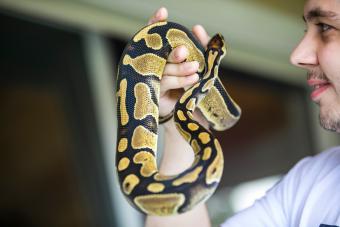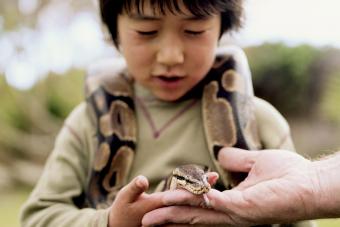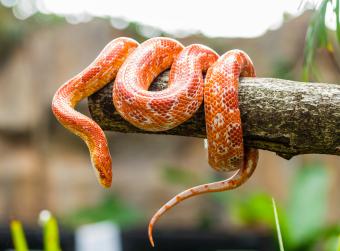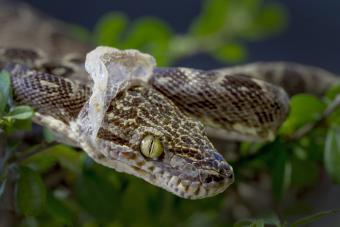
Ball python information and facts are fun and interesting, especially if you are thinking about owning one of these snakes. While ball pythons may initially seem like a scary choice for a pet because they are constrictor snakes, they are gentle, docile, and make great pets.
All About Ball Pythons
There are 42 species of pythons in the family Pythonidae; the ball python is just one of 10 species in the genus Python, which is a sub-grouping within this family of reptiles. Pythons are constrictors, which means they wrap their bodies around prey and squeeze until they suffocate. Ball pythons are one of the smallest of all pythons, and only grow to about 3 to 5 feet long.
Interesting Ball Python Snake Information and Facts
Knowing and understanding a few basic ball python facts will help you decide if you would like to own one as a pet. The ball python can live to be up to 50 years old! They earned their name because they tend to curl up into a ball if they feel threatened, and they love to hide in dark places. They can make good pets, as they can be quite friendly with humans if handled often from a young age. However, make sure you consider all the facts before purchasing one of your own.
Ball Python Appearance

A ball python has a flat head and boxy snout. Their coloring is black with pale stripes on the face and black stripes forming a mask over the eyes. The body of a ball python has large spots of brown outlined in white and black. The spots on young ball pythons are yellow and green, outlined in white and black. A healthy ball python will be round and firm.
Lifespan of the Ball Python
Captive ball pythons can live up to 50 years, but the average lifespan is approximately 30 years. Their life span in the wild is much shorter due to predators.
Origin of the Name Ball Python

In Europe, the ball python is referred to as the royal python. In the United States, the name ball python was given to them because they curl themselves into a ball with their head in the center when they are nervous or upset.
Natural Habitat: Where Do Ball Pythons Live?
Ball pythons originated and live in the dry grasses of the savanna desert or along the forest edges in the western parts of sub-Saharan Africa. They can climb into trees, but they rarely do. In captivity, these pythons need a secure habitat such as an aquarium with a lid from which they can't escape. An adult ball python will need a cage that is at least 36-inches in length, such as a 40-gallon aquarium.
Heating a Ball Python Terrarium
Ball pythons require a warm environment. Therefore, the cage should have an under-tank heater, such as a heat mat or heating tape on one side of the enclosure to keep the snake warm. Keep a thermometer in the cage to monitor the temperature and keep it at approximately 80 to 85 degrees Fahrenheit. Ball pythons have sensitive skin and are easily burned, so using a heat rock in the enclosure is not recommended.
Ball Python Terrarium Humidity
Ball pythons are accustomed to a moderately humid environment. If the habitat is too dry, the snake may not be able to shed their skin or defecate. The humidity should be approximately 50 percent for the ball python to remain healthy.
Hiding Places for the Ball Python
In the wild, ball pythons hide under rocks or inside dark crevices. So, it is important to provide your pet with several hiding spots in their cage. Most pet supply stores carry hiding spots made from bark, cork, and other suitable materials that will serve this purpose and also look quite natural in your pet's habitat.
Ball Python Diet

What do ball pythons eat? Ball pythons hunt rodents in the wild, such as rats, gerbils, and jerboas. In captivity, ball pythons will eat either a live mouse or small rat once per week. Some pet pythons can be trained to eat pre-killed mice, which is best done while they are still hatchlings. However, you can also train an adult ball python to accept pre-killed food if you are patient and persistent.
Ball Python Reproduction
Ball pythons are sexually mature at approximately 1 to 3 years of age, depending on their sex. Breeding typically occurs in mid-September to mid-November. These snakes lay eggs that have a leathery shell. The female will breed only once every two or three years, and she will drop between four and 10 eggs each time.
You can tell a female is bearing eggs because her color will turn dark. After her eggs are dropped, she will coil herself around them to keep them warm. Incubation takes approximately 60 days, during which time the female will stay with her eggs and not eat.
Ball Python Shedding
Ball pythons shed their skin periodically. Once their eyes begin to look cloudy, shedding will commence very soon. The process takes approximately one to two weeks. It is helpful to have a tree branch in the cage so your snake can rub up against it to help shed the skin.
Predators of the Ball Python
In the wild, ball pythons have many predators, and very young and small snakes are most vulnerable. Their predators can include:
- Larger snakes
- Birds
- Carnivorous mammals
- Spiders
- Insects
- Large frogs
Are Ball Pythons Friendly?

Ball pythons are docile snakes, but they can be very friendly and comfortable being handled by humans if you hold them once per day and handle them gently. An adult ball python will enjoy wrapping themselves around your arm or waist, but you can easily unwrap them when you need to. Keep in mind that these snakes are head shy, so you should avoid making sudden movements when interacting with one. After holding your snake, always wash your hands.
Are Ball Pythons Poisonous?
Ball pythons are non-venomous snakes. They are constrictors, and subdue their prey by squeezing it.
Ball Python Color Variations
Not only are ball pythons sweet and gentle, but they're also stunning. This species comes in numerous colors and patterns. There are reportedly thousands of different morphs, or genetic mutations that lead to their unique coloration and appearance.
The typical ball python coloring, sometimes referred to as wild type, is brown and black. However, other common morphs include albino, banana, axanthic, pastel, and yellow belly. A few rare morphs are pastel zebra, piebald, and dreamsicle.
Ball Pythons Live for Many Years
If you are interested in owning a ball python as a pet, visit your local pet shop or search for a local reptile club to find a breeder. Remember, ball pythons can live up to 50 years, so you'll most likely be making a lifetime commitment to care for your pet snake. Review all ball python facts to prepare yourself before bringing this docile pet into your home.







